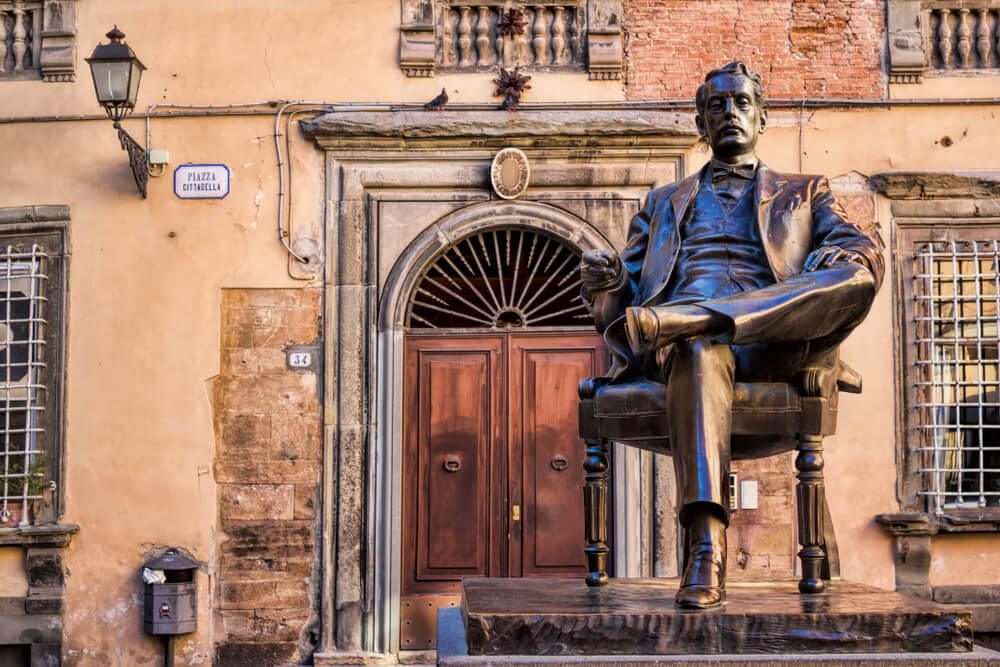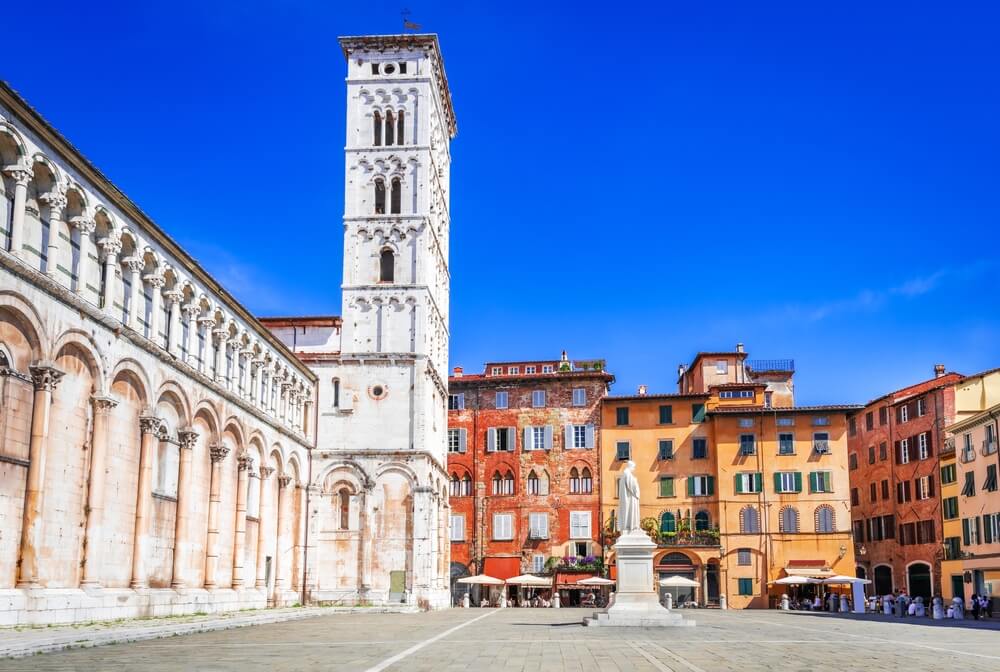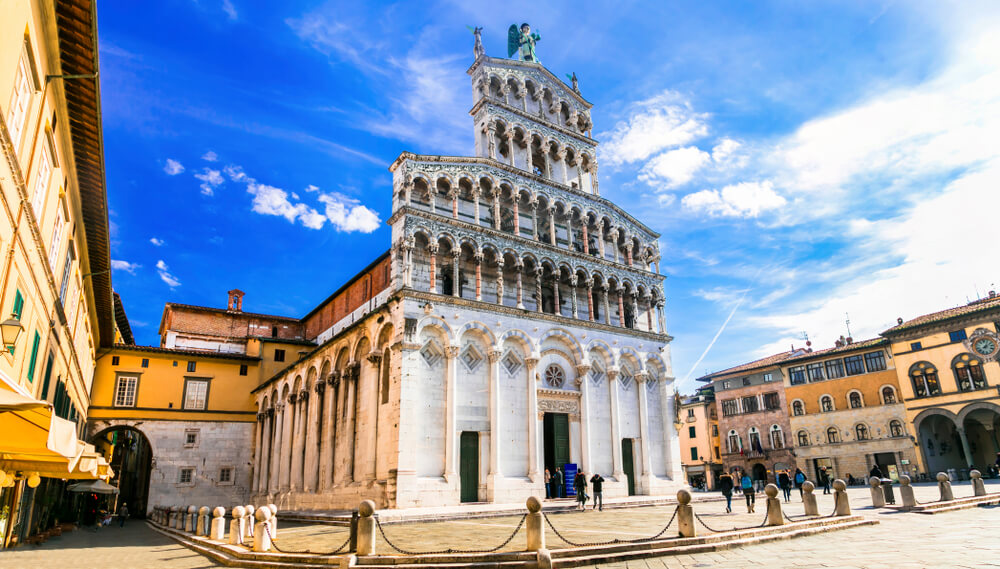45 things to do in Lucca
Bookings For You, Family travel, Inspiration, Italy, Tuscany, Tuscany
Lucca is one of our favourite cities, not just in Tuscany, but anywhere in Italy. Smaller than its more famous neighbours Florence, Pisa or Siena, some might argue that it’s also a little bit more authentic too.
Here’s our guide to the top 60 things to do in Lucca.
Cycle or walk around the city walls
Over the centuries, Lucca has actually seen three sets of city walls. The ones that you see today are the third set dating back to the Renaissance period. They were constructed in the period between 1544 and 1650. At 4.2 kilometres long, it will take approximately 45 minutes to walk the entire length of the walls. That said, we suggest you leave a little longer to allow for photo opportunity stops! Alternatively, if you prefer a faster pace, on a Saturday morning, you will find the Mura di Lucca Park Run, a non-competitive run every Saturday morning. Or, at any time, you can hire bikes and opt to cycle them instead.
Go inside Lucca’s walls
As well as walking on Lucca’s elevated walls, it is also possible to go inside them. The result of a major restoration project in the 1980s, visitors to Lucca can now enter the underground galleries of the bastions.These would once have been used by the soldiers guarding the city. But now, visitors can peacefully enter the walls and discover their underground passages. Those open to the public today are at the bastions of San Martino, San Salvatore, Santa Maria and San Paolino.
Discover Lucca’s gates
Lucca has six gates in total. The oldest date back to the second half of the 16th century and first half of the 17th. These include the earliest – the Porta San Pietro – built in 1565, followed by the Porta Santa Maria in 1592. These are positioned on the southern and northern sides of the city respectively. Next to be built was the Porta San Donato Nuova, which dates back to 1628. The three later gates were opened in the 19th and 20th centuries. They include the Porta Elisa (1811), the Porta Vittorio Emanuele (1910) and the Porta San Jacopo (1930). All these later gates were opened to aid the movement of traffic to and from the city.

Enjoy the opera
Lucca is an incredible city to visit if you’re an opera lover. The Teatro di Giglio is Lucca’s very own opera house. Located in the piazza of the same name, the building you see today dates to the early 19th century.
Visit the botanic gardens
The Orta Botanico di Lucca is an open-air museum that has existed for over 200 years. Whilst not large, it is home to ancient trees and an array of unusual plants and scientific collections that have been curated by botanists there since the 19th century. These include a collection of edible wild plants and a medicinal plants collection. It’s also home to some turtles that enjoy sunning themselves on the water lilies and two rather large glass houses.
Climb the Torre Guinigi
Arguably the most famous of Lucca’s landmarks, the Torre Guinigi is a 45 metre tall tower. There are 223 steps in total to get from the bottom to the top. With no elevator, it’s may not be suitable for everyone. But the majority of the steps are fairly broad and not particularly steep to climb. This Romanesque Gothic tower was constructed in the 14th century and it famous for the holm oaks that grow at the top. If visiting during the Summer months, we recommend you climb first or last thing in the day – the light is beautiful at these times and you will find it a little quieter.
Visit the shrine of Saint Zita in Lucca’s Church of San Frediano
So the story goes, Zita was a peasant girl who went to work as a servant in Lucca when she was 12. She had a strong work ethic and a sunny disposition. She also swiftly developed a habit of distributing leftover bread to the poor people of Lucca. Unfortunately, a fellow servant revealed all to the family she worked for. When the head of the family confronted here and pulled open her apron, flowers fell out, not the bread you would have expected. Zita passed away aged 60 in 1272. According to the legend, the church bells began to toll spontaneously when she died. She was subsequently made a saint, not just of Lucca but also of servants and lost keys. The city celebrates her life on 27 April each year. You can pay your respects at the Church of San Frediano in Lucca where she lies, dressed in full view to visitors.
Eat!
We think Lucca must have the biggest concentration of excellent restaurants than any similar sized city in the world. Don’t miss the opportunity to taste Lucca’s most famous dishes. The first is the buccellato. This is best described as an aniseed flavoured cake or bread and it’s absolutely delicious! Or, opt for the zuppa di farro, a soup made with farro (spelt).
Learn more about the origins of the Italian nation
The Museo del Risorgimento in Lucca tells the story of the origins of the Italian nation from a very local point of view. It explains the role of those living in Lucca through both an analysis of national and local events.
Visit the Museo Paolo Cresci per la Storia della Emigrazione Italiana
Between 1860 and 1960, Italian emigration played a fundamental role in Italy’s national history. This museum brings that story to life through a series of letters, photographs, diaries and documents. It traces the stories of some of those who left Italy in search of a better life elsewhere, an experience that was not always smooth and often painful.
Discover the Museo Antica Zecca di Lucca
This museum tells the story of the oldest mint in Europe which produced coins for over a thousand years from 650 to 1843. The museum has a reconstruction of a historic workshop, complete with vintage machinery. It also has a large collection of ancient coins and medals on display.
Enjoy an aperitivo in the Piazza dell’ Anfiteatro
This is arguably the most famous (and certainly the most photographed) of Lucca’s squares. Built in the 1st century AD, it was once the setting for gladiator fights and games. Over time, its use has changed. For example, from the 6th century AD, during the Gothic wars, the square was fortified and its outer arches closed to prevent it falling into enemy hands. After this, buildings were used as houses and eve as prisons. Then in the 19th century, the buildings that occupied the floor of the ancient arena were pulled down and the inner area became the piazza you see today. Now, restaurants and cafes line the piazza and it’s a buzzing place to enjoy an aperitivo before dinner. Just one word of caution… the piazza is home to some incredible restaurants but others are more what we would class tourist traps. Check tripadvisor reviews carefully before choosing where to eat and drink!

Climb the Torre delle Ore
At the peak, Lucca was actually home to more than 130 towers. These would have been built by families as symbols of their power and wealth. This is the second of Lucca’s remaining towers that visitors are able to climb today. Situated on the Via Fillungo, at 50 metres tall, this tower sits slightly taller than the Giunigi Tower. There are 207 wooden steps to climb to the belfry. From here, there are fantastic views over the streets, palaces, roofs and churches of Lucca. It is also possible to view the clock. This dates back to 1752 and was the work of Swiss watchmaker Louis Simon. The dial was the work of local watchmaker Sigismondo Caturegli and the three bells were cast by another local Stefano Filippi.
Hire bikes and cycle the Puccini trail
There are a number of bike hire shops in Lucca. Hop on two wheels for the day and cycle the full length of the Puccini trail, discovering buildings and landmarks that tell the story of Puccini’s life. Or, if the full 53 km trail is a bit too taxing, opt to just cycle a short part of it. Some sections are on the roads around Lucca whilst part of the trail is on specific cycle and walking paths. Just a word of warning – the signposting is not particularly clear in some sections.
Check out the bargains at Lucca’s market
Lucca holds a weekly market every Wednesday and Saturday at the Le Tagliate car park. It definitely caters more to locals than holidaymakers but we still recommend you visit. We picked up some beautiful fabrics last time we visited. There are also stalls selling clothing, food and homeware. Incidentally, if you’re looking to do your grocery shopping at the market, then there is a farmer’s market every Saturday (and Wednesday during the Summer months) at Foro Boario. This is a great opportunity to pick up freshly grown and seasonal produce from independent producers. And on Wednesdays throughout the year, there is an organic and fair trade food market in the Piazza San Francesco too.
Shop for antiques
As well as the regular food markets, Lucca also hosts an antiques market on the third Saturday and Sunday of the month. This is mainly centred around the Piazza San Guisto and Piazza Antelminelli but don’t be surprised to find stalls popping up elsewhere! With over 200 stallholders taking part regularly, it is one of the biggest in Italy. Incidentally, there is also a handicraft market on the last weekend of every month in the same location.
Discover how life would once have been lived in Lucca
Visit the Museo Nazionale di Palazzo Mansi to marvel at the sumptuous former home of a local merchant family. The Manzi’s were clearly an extremely wealthy family, with rooms inspired by the Baroque style of architecture.
Admire the Colonna della Madonna dello Stellario
On the outskirts of the old town is a beautiful Baroque statue showing the Madonna with her billowing robes atop a column. Many claim that it is the first statue made in Italy that was dedicated to the Immaculate Conception. Interestingly, you may want to visit both in daylight and at nighttime. The column looks quite different lit up at night.
Visit Villa Reale
Villa Reale di Marlia is a late 15th century Renaissance villa surrounded by the most spectacular gardens. The gardens themselves date back to the late 17th century and are a perfect example of the Giardino all’Italiana style. Once owned by Elisa Bonaparte Baciocchi (the sister of Napoleon), the property since passed to Count Pecci, but was sold in 2015. These days, it serves as a magnificent venue for cultural events such as the Lucca Classica Music Festival, the Exhibition of Ancient Camellias of Lucca and the Festival Le Rinascenze. An entry ticket allows visitors access to the marvellous gardens. Enjoy a stroll around them followed by refreshments in the cafe within the pavilion.
Take a day trip to the coast
Lucca is a great base from which to visit Tuscany’s coastal resorts. It’s only a 35 minute drive to Viareggio from Lucca, and only a few minutes further on from here is Forte dei Marmi. Both resorts sit on a 25 km stretch of Versilia coastline that attracts wealthy Italians looking to escape the heat of the Summer in the city. The area is famous for its private beach clubs and vibrant night life. It once attracted the rich and famous. These days, it perhaps doesn’t have quite the same status as it did back then, but it still attracts a rather wealthy, upmarket set.
Visit Gipsoteca Liceo Artistico Musicale e Coreutico ‘A Passaglia’
This museum holds a collection of plaster casts dating back to the foundation of the Academy of Painting and Drawing School of Lucca in 1640. It has over 500 examples of plasterwork on display including statues, groups and anatomical details. It allows students at the school to study, reproduce and restore the works of art.
Learn about Puccini
Puccini is Lucca’s most famous resident. Visit the house where he was born – Museo Casa Natale di Giacomo Puccini – to learn more about his life and personality as well as to gain a better understanding of some of his works. These include La Boheme, Madama Butterfly, Tosca and Turandot.
Listen to Puccini’s opera
Puccina e la sua Lucca is a permanent music festival in Lucca with weekly concerts celebrating the works of this great composer. In total there are seven different events to choose from. These range from performances of ‘Puccini and Mozart’ to renditions of ‘Puccini and the Traditional Neapolitan songs’. Concerts are held in the Church of San Giovanni. On the plus side, the quality of the performances and the acoustics of the church are outstanding and we can highly recommend you add this to you list of things to do in Lucca when you visit. However, if you’re attending a concert in the hot Summer months, we definitely recommend you bring a fan. It can get extremely hot under the lights.
Enjoy the open-air cinema
In the Summer months, an open air cinema comes to Lucca. Showing a film each night (and with a special family evening) it’s a great way to spend an evening for just a handful of euros. The cinema area is cordoned off with fencing but you’ll find families sneaking a peak of the film for free from outside.
Visit the Sito Archeologico Museo Domus Romana ‘Casa del Fanciullo sul Delfino’
This is an archeological site right in the historic centre of Lucca. It holds over 2000 years of history where you can see evidence of Roman, Lombard, Medieval and Renaissance finds all in one place.
Get medical in the Palazzo Pfanner
This is best described as a fairytale mansion with a stunning garden. Not surprisingly, it has been used as a film set on a number of occasions. These days it is home to an exhibition of medical-surgical instruments and medical documents that once belonged to an ancestor of the family that still own the property today.
Take to the water
Near to Lucca flows the River Serchio. At the Serchio River Park, you can hire a canoe and enjoy getting out on the water. There are a number of companies offering excursions.

Visit the Cattedrale di San Martino
Visitors to the Romanesque Cathedral of San Martino will immediately be struck by its impressive and extremely beautiful facade. This is decorated with a sculpture of San Martino (Saint Martin). However, inside, there is just as much to marvel at. Discover the Volto Santo, an ancient wooden crucifix. Set within a small chapel to the right hand side of the nave, it is believed to be the work of Nicodemus who witnessed the crucifixion. As a result, it’s considered in the Christian world to be the ‘true’ portrait of Christ. In reality, experts are more inclined to believe it’s a 13th century copy of an 8th century ‘original’. But it’s still incredible to consider how many pilgrims have journeyed to pay their respects to the crucifix. Also of note in the cathedral is Jacopo della Quercia’s tomb of Ilaria del Carretto. Ilaria died aged just 24 after giving birth to her second child. The tomb depicts her faithful dog, waiting at his mistresses feet for her to wake.
Climb the Campanile
If you’re headed to the Cathedral of San Martino, and haven’t taken the opportunity to climb Lucca’s other tower, you may want to take the opportunity to climb the Campanile here. On the plus side, this bell tower has a handful fewer steps than the Torre Guinigi – a mere 217 in total! And, actually, it’s a great option if you want to enjoy a view of Lucca’s more famous tower rather than climb it!
Celebrate Lucca’s Luminara di Santa Croce
On 13 September each year, Lucca’s residents celebrate the Luminara di Santa Croce. On this day, the Volto Santo is paraded through the streets of Lucca in a moving and immensely beautiful candlelit procession. All the city’s electric lights are turned off and candles burn in each of the city’s windows. The procession starts at around 8 o’clock in the evening. It begins at the Church of San Frediano and makes its way to the Cathedral of San Martino. Priests lead the way dressed in white robes and holding banners and torches whilst hundreds of residents will follow behind, many dressed in historic costumes.
Pay your respects at the Church of San Michele in Foro
This church is set in the heart of the large Piazza San Michele. It’s also home to the second of Lucca’s saints – Saint Davino Armeno – who can now also lay claim to being the oldest Italian mummy of a saint. Surprisingly little is actually known about the life of Davino. We do know that he undertook a number of pilgrimages and gave to the poor. And he was actually on one of these pilgrimages when he arrived (and died) in Lucca en route to Santiago di Compostela in Spain on 3 June 1050. As with Saint Zita, the body is on full display for visitors to see.
The Church of San Michele in Foro is a spectacular example of a Pisan-Romanesque facade. This green and white marble church also boasts a lovely bell tower and is topped with a large gilded statue of Aechangel Michael slaying a dragon and flanked by two angels.
Go Shopping
Lucca’s charming streets are filled with a selection of wonderful independent shops and businesses. The Via Fillungo is the main shopping street that runs through the heart of the city but there are plenty of side streets worth exploring too. These include Via Chiasso Barletti, Via Santa Croce, Via Buia and Via Santa Lucia but you’ll discover stores all over the city. Even if you’re just window shopping, many of the shopfronts themselves are well worth seeing – they can often be rather beautiful.
Enjoy the festive celebrations
Like many towns and cities in Italy, Lucca has plenty to get you in the festive spirit each December. There are several Christmas markets that run from early December through to the new year, the most important of which is in the Piazza Napoleone. A temporary ice skating rink is also erected along with a carousel, making it a great family friendly day out.
Get gruesome at Lucca’s Torture Museum
This is one of Lucca’s smallest museums but it’s definitely not for the faint hearted! With displays of instruments used in the past to torture individuals, it’s up to our imaginations to picture how they were used.
Immerse yourself in Lucca Comics & Games
This is arguably Lucca’s most famous festival and attracts thousands of visitors each year. Held in late October and early November, it’s extremely popular with those interested in comics, cartoons and video games and is second only to Comiket in terms of size. Lucca certainly looks slightly different when it’s taking place – expect to see fans dressed as their favourite characters wandering through the streets, and exhibits and workshops filling the city.
Tick off Lucca’s other churches
Lucca is known as the ‘city of one hundred churches’ so there are plenty of churches to tick off the list as you explore the city. As well as the afore-mentioned Duomo di San Martino, the Basilica di San Frediano and the Church of San Michele in Foro, there are plenty of other religious buildings of note. We particularly recommend you pay a visit to the Chiesa di San Romano, the Chiesa Di Santa Maria Del Giudice, the Oratorio Dell’angelo Custode and the Chiesa di Sant’Anastasio.
Enjoy the celebrations on the Night of the Stars
We recommend heading to the city walls of Lucca on this particular night in August. Events start when the sun has gone down at 9.30 pm and go on well after midnight. There are a number of different performances taking place as you go around the walls, including opera concerts, choral music and tango music. We particularly loved the latter and whilst we confess to having absolutely no idea of what we were doing, the locals were delighted to take us under their wings and try to teach us!
Enjoy a day trip to Pisa
Pisa is less than half an hour away by car from Lucca and makes for a fantastic day trip. Incidentally, it is also possible to cycle from one city to the other. The route is approximately 25 km long however, you could always take the bikes back on the train if you find it’s too far to attempt to cycle both ways. Whilst we always tell our guests that there is so much more to see and do in Pisa than just its Leaning Tower, it is nevertheless still a small enough city that you can easily do justice to it in a day. Discover the top 10 things to do in Pisa during your trip.
Enjoy a day trip to the Cinque Terre
Another superb day trip using Lucca as a base is the Cinque Terre. This is a collection of five villages – Monterosso, Vernazza, Corniglia, Manarola and Riomaggiore – all tucked into the Ligurian coast. Their pastel coloured homes are simply charming. However, they’re incredibly popular and expect to be have to jostle your way through the crowds if visiting in the peak Summer months. This is definitely a trip we would recommend on a stay in one of our villas in Lucca in the Spring or Autumn. Discover the best way to explore the Cinque Terre with Bookings For You.
Take part in one of Lucca’s music festivals
Lucca boasts a number of festivals that take place annually. Our favourites are the Lucca Blues Festival held every April and the Lucca Summer Festival held every July. The latter attracts some incredible artists. Over the years these have included Bob Dylan, Elton John and David Bowie. More recently in 2024, acts included Eric Clapton and Ed Sheeran amongst others. Bryan Adams, Alanis Morissette and Simple Minds are already confirmed in the 2025 line-up. Finally, in October there is Lucca Jazz Donna, celebrating female jazz musicians.
Run around Lucca
Park runs have become incredibly popular the world over and Lucca is no exception in getting in on the action. Every Saturday at 9 a.m. runners meet at the Piazzale Vittorio Emanuele and run around the city walls. It is free to join in but just make sure you register beforehand. Alternatively, if you’re looking for something more challenging, why not consider taking part in the Marcia delle Ville (Run of the Villas). There are different length courses to suit different ages and abilities – 3.5 km is the shortest route and 28 km the longest – and the race winds its way through the historic villas that have made Lucca and the countryside around it so famous. If it tempts you to take part, you’ll be pleased to hear that many of the villas and farmhouses that the run passes through will offer up local food and drinks to sustain you!
Go wine tasting
Many of the hills around Lucca are planted with vines and olive trees and there plenty of wineries within easy reach of Lucca’s city centre where you can enjoy a tour and tasting.
Walk along the Aqueduct of Nottolini
This is a Roman style aqueduct built by local engineer and artist Lorenzo Nottolini. Built during the first half of the 19th century, it is no longer in use but has been preserved as an architectural monument. More than 400 arches support the stone channel. A 4 km path just to the west of the aqueduct takes you on a rather pleasant walk where you can admire its beauty.
Enjoy a stroll around the gardens at Villa Grabau
Just 7 km from the heart of historic Lucca is Villa Grabau. Whereas Villa Reale is the perfect example of an Italian garden, Villa Grabau will also show you the perfect example of an English garden. The colours are spectacular and it’s the perfect setting to spend a quiet couple of hours. It is also possible to enjoy a guided tour of the villa’s main rooms.
Read your way around the Bibliteca Civica Agora
The Bibliteca Civica Agora is a public reading library that opened in 2002. If you’re a book worm, it’s a must see. There are some impressive Italian collections as well as a number of books available in foreign languages and an excellent selection of English books. These include plenty of DK guidebooks if you’re needed some inspiration on where to go next on your Italian holiday!


